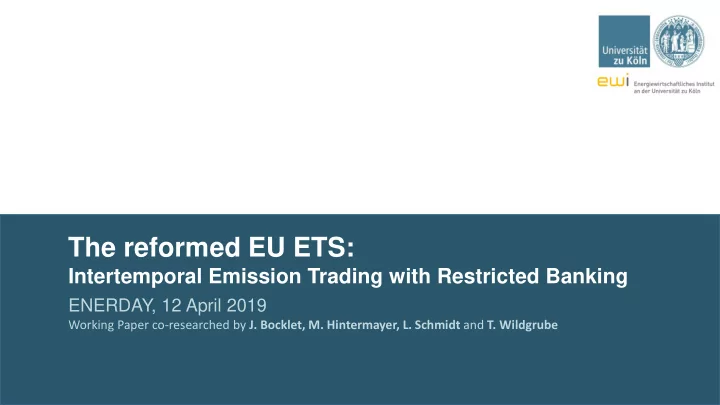

The reformed EU ETS: Intertemporal Emission Trading with Restricted Banking ENERDAY, 12 April 2019 Working Paper co-researched by J. Bocklet, M. Hintermayer, L. Schmidt and T. Wildgrube
EU ETS reform: regulation for phase IV (2021-2030) Price development EU ETS Three principal amendments: (1) Linear reduction factor of cap 25 April 2018: revised set to 2.2% for phase IV EU ETS Directive (phase III: 1.74%) 20 Euro / ton CO 2 enters into force (2) Introduction of the Market 15 Stability Reserve (MSR): corridor for allowances in 10 circulation (3) Cancellation mechanism : 5 volume in MSR is limited to previous year’s auction volume 0 Jan-15 Jan-16 Jan-17 Jan-18 Jan-19 Total cap becomes endogenous Source: ICE (2019) 3
I. Discrete dynamic optimization model II. Results III. Further research and discussion 2
Our research fills an important gap in the literature Discrete time, but qualitat. Our contribution: analysis or iterative models: MSR Cancellation & Overlapping National Policies; e.g. Beck & New EU ETS regulation accurately depicted Kruse-Andersen (2016), Carlen et. al (2018) in a discrete time model Modelling of the endogenous cap Quantification of the impact of MSR, Continuous time: Cancellation Mechanism and LRF Without latest reform: Quantification of the impact of the MSR; e.g. Perino & Decomposition of the price effects of the EU Evaluation of dynamic Willner (2016) efficiency of different MSR ETS amendments Salant (2016) designs; e.g. Neuhoff et al. (2012), Schopp et al. (2015) Evaluation of the impact of amendments on dynamic efficiency Theoretical foundation for intertemporal trading Hotelling (1931) Rubin (1995) Chevallier (2012) 20
A market equilibrium is derived where firms minimize their costs given the new market rules Cost minimizing, price-taking firm with perfect foresight decides on emissions e(t), abatement u-e(t) and banking b(t). Parameter interest (r), counterfactual emissions (u) and cost Firm level parameter (c) are exogenous: allowance prices demand Market equilibrium given individual optimality conditions, supply and regulatory rules: Market level Icons made by Freepik from https://www.flaticon.com. 6
Market prices increase with the interest rate if private bank > 0 Equilibrium price path: > 0, if b(t) = 0 =0, if b(t) > 0 • • Price develops according to Hotelling rule Price increases at less than the interest • No bank all allowances issued are (1931) for extraction of finite natural resources • used abatement level and price level Firm is indifferent between investment at the capital market and extraction of the develop accordingly resource 8 Icons made by Freepik from https://www.flaticon.com.
I. Discrete dynamic optimization model II. Results III. Further research and discussion 2
The price increases with the interest rate until 2038 11
The increased LRF reduces overall emissions cap by 9 billion 9 billion EUA 2 billion EUA 12
The MSR shifts emissions from the present to the future MSR fully depleted 13
I. Discrete dynamic optimization model II. Results III. Further research and discussion 2
Discussion Contribution of the research Open questions Contribution of the model Why did the EUA price increase last year? Accurate discrete time representation of Bounded rationality of market participants regulation in place Regulatory uncertainty Three simple exogenous parameters; Other explanations? robustness check through sensitivity analysis How does the new EU ETS interact with other national or European policies? Insights into the EU ETS Combination with a EU-wide price floor LRF has a stronger impact than the Combination with national price floor cancellation of allowances Price effects of the reform more medium Support for renewable energies (or other term demand shocks) 12
Thank you for your attention! Theresa.Wildgrube@ewi.uni-koeln.de
References
Beck, U. R. and Kruse-Andersen, P. (2018). Endogenizing the cap in a cap-and-trade system: assessing the agreement on EU ETS phase 4. De Okonomiske Rads Sekretariatet, Denmark , Working Paper. Carlen, B., Dahlqvist, A., Mandell, S., and Marklund, P. (2018). EU ETS emissions under the cancellation mechanisms : Effects of national measures. National Institute of Economic Research , Working Paper No 151. Chevallier, J. (2012). Banking and Borrowing in the EU ETS: A Review of Economic Modelling, Current Provisions and Prospects for Future Design. Journal of Economic Surveys , 26:157 – 176. Hotelling, H. (1931). The Economics of Exhaustible Resources. Journal of Political Economy , 39(2):137 – 175. Neuhoff , K., Schopp, A., Boyd, R., Stelmakh, K., and Vasa, A. (2012). Banking of surplus emissions allowances - does the volume matter? DIW Discussion Papers , 1196. Perino, G. and Willner, M. (2016). Procrastinating Reform: The Impact of the Market Stability Reserve on the EU ETS. Journal of Environmental Economics and Management, 52:37 – 52. Rubin, J. D. (1996). A Model of Intertemporal Emission Trading, Banking and Borrowing. Journal of Economics and Management , 31:269 – 286. Environmental Salant, S. (2016). What ails the european union’s emission trading system. Journal of Environmental Economics and Management , 80:6 – 19. Schopp, A., Acworth, W., Huppmann, D., and Neuhoff , K. (2015). Modelling a market stability reserve in carbon markets. DIW Discussion Papers , 1483. 28
Recommend
More recommend